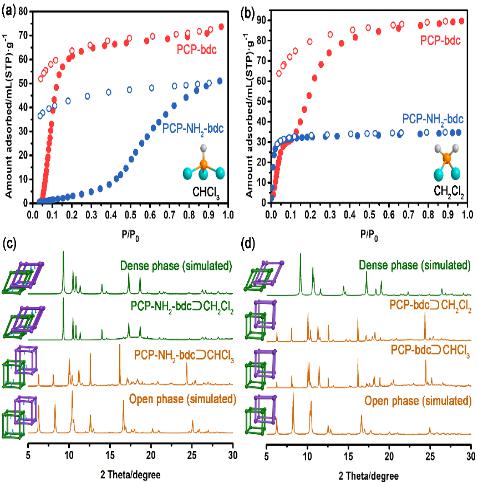Molecular recognition plays a key role in numerous biological, chemical and environmental processes. Recently, inspired by various biomolecules (for example, proteins) with high degrees of structural freedom for precise molecular recognition, soft porous coordination polymers (PCPs) or metal-organic frameworks (MOFs) exhibiting guest‐triggered structural transformations have attracted significant attention. Nonetheless, until recently, the focus has been on investigating the structural flexibility by utilizing crystallographic diffraction and sorption profiles, and few reports on material design from energy perspectives are available.


Modulation of the Edef of soft PCPs for selective gate opening adsorption of CHCl3 over CH2Cl2
Recently, the research team led by Prof.Fengting Li from College of Environmental Science and Engineering, Tongji University, in collaboration with Prof. Susumu Kitagawa from Kyoto University (Academician of the Japanese Academy of Sciences), proposed a new strategy tocontrol the flexibility of PCPs called “Structural‐Deformation‐Energy‐Modulation”.They demonstratedstructural deformation energy (Edef) modulation via encoding inter‐framework hydrogen bonds into a soft PCP with an interpenetrated structure. As a proof of this concept, the enhanced Edef of PCP enables a selective gate‐opening behavior toward CHCl3 over CH2Cl2 by changing the adsorption‐energy landscape of the compounds. This mechanism is not clarified in a method relying solely on experiments, and could only be determined and controlled by clarifying the respective energy states in addition to the experimental informationof an initial and the following transformed states, in particular, the energetic‐landscape analysis focusing on deformation energies.This strategy provides a future standard for the design of soft porous materials with functional flexibility. Dr.Yifan Gu is the first author of this paper. This work was published on Angewandte Chemie International Edition(https://onlinelibrary.wiley.com/doi/full/10.1002/ange.202003186).
Hierarchical porosity and sufficient exposing active sites are primary features for the robust frameworks designed towards efficient adsorption, especially large molecules.Tao Feng, a PhD candidate, built a hierarchical porous CuBTC(HKUST-1is a metal organic framework (MOF) made up of copper nodes with 1,3,5-benzenetricarboxylic acid struts between them)for desulfurization research.Herein, they introduced a newstrategy called linker transformation, to create mesopores and Cu2O nanoparticles in CuBTC simultaneously. Through this method, they constructed hierarchically porous CuBTC with tunable pore size distribution, and maintained the crystallinity and stability after adding transformed linkers. Furthermore, linker transformation promotedthe uniform distribution of Cu2O nanoparticles immobilized in an open framework of CuBTC. The hierarchical porous structure would enable the big size sulfur compoundsdiffuse more easily, while the small Cu2O nanoparticles were highly dispersed, which also led to betterdesulfurization adsorption performance. The strategy presents here may provide new thoughts for designing more abundant MOF structures and further expanded their application ranges.This work was published onJ. Mater. Chem. A.
For the past few years, Prof. Fengting Li 's team has carried out a lot of cutting-edge researchto design and prepareenvironmentally functional porous materials for the identification and separation of pollutants, the purification of clean energy, and the detection of ultra-trace pollutants. The research outcomes mentioned above weresupported by the National Natural Science Foundation of China, the International Science and Technology Cooperation Project of the Ministry of Science and Technology, and the Shanghai Municipal Government’s International Science and Technology Cooperation Program.
References:
1.Gu, Y., Zheng, J. J., Otake, K. I., Sugimoto, K., Hosono, N., Sakaki, S., Li, F.& Kitagawa, S, Angew. Chem. Int. Ed, 2020(link:https://doi.org/10.1002/anie.202003186)。
2.Feng, T., Wang, Y., Wu, Y. N., Kabtamu, D. M., Laszlo, K., &Li, F., J. Mater. Chem. A, 2020, 8, 8678 - 8683(link:https://doi.org/10.1039/c9ta13505g)。
3.Li, J., Yu, C., Wu, Y. N., Zhu, Y., Xu, J., Wang, Y. &Li, F, Environ. Int., 2019, 125, 135-141(link:https://doi.org/10.1016/j.envint.2019.01.033)。
4.Xu, J., Yu, C., Feng, T., Liu, M., Li, F., Wang, Y., & Xu, J., Nanoscale, 2019, 10, 19390-19398(link:https://doi.org/10.1039/c8nr05098h)。。